A lot has happened in the last couple of weeks and I really haven't had time to type it all out. The weekend after I went on the hiking and clam digging trip, I went with the same company to the DMZ.
As many of you may know, South Korea is, in fact, at war with North Korea. There has never been a treaty signed between the two nations and they are very serious about the threat posed by the North, here. The DMZ is the zone around the Line of Demarcation, drawn arbitrarily around the 38th Parallel, that separates North from South.
In a lot of respects, Koreans think of themselves as a Nation divided. There are still many families with members stuck in the North, people who were separated from their parents, from their siblings, from their friends.
While the respective governments plot each other's demise, the people just want to see their loved ones again. I mentioned before that there was a ship sunk off the coast back in April that was proved (though Pyongyang still denies it) to be a product of North Korea, and there were shots fired the other day in the DMZ, but in general, the hostilities are winding down from earlier in the year.
Just this week, there was a reunion of families split by the war. The nation watched on TV as old ladies, bent and gnarled with age, dressed in bright hanboks, greeted their long lost sons and daughters. I didn't even know what they were saying but I was crying when I saw the expressions on those faces. They didn't care that the whole nation was watching, they were crying and smiling; holding each other with a fierce joy that spoke of their years of isolation.
My trip to the DMZ was far less dramatic, though very educational. I met the bus in Seoul at the usual ungodly hour. This is about the fifth trip I've taken with this company (Adventure Korea) so the woman who was checking names recognized me. I had spent the last trip (the hiking and clam digging trip) hanging with her and her brother. We drove up North and had to register at the Civilian Control Center, which is apparently as far north as Korean Nationals can go. This seems strange to me, that Koreans aren't allowed inside the DMZ and Americans are, but then, I guess it wasn't Koreans who made those particular rules.
The Civilian control center had a lot of neat stuff to look at while they were registering our names with the government (everyone must to this to enter the DMZ). There was an epic looking train that had been carved up by the shrapnel during the Korean war. There were impressive looking guard towers that I got yelled at for taking pictures of. There was also a wall where people could hang their wishes for peace. In the distance, you could see a bridge leading over a river and into the DMZ. Of course, there was barbed wire everywhere.
Here, there is a Chusok altar. Chusok being the Korean version of Thanksgiving where all Korean families gather to honor their ancestors and show devotion to their living relatives. Defectors, people who come from the North to the South, can't go home to honor their ancestors or even some of their living relatives, so there is a giant altar built here, at the closest point to North Korea that Korean citizens can go without joining the army, for people to come during Chusok and honor the dead and the trapped.
The second stop was inside the DMZ, in Panmunjom, the only South Korean village inside the DMZ. People who agree to live there are exempt from taxes, and paid incredible amounts even though they are only farmers. They are exempt from military service (are Korean males are required to serve), although I would think that they would want the training seeing as they are literally on the front lines.
There is a North Korean Village in the DMZ, but, as I mentioned before, it is a propaganda village. Nobody lives there and its only purpose is to broadcast propaganda to anyone cloase enough to hear - and, of course, to give the impression of wealth and well-being. It does, however, have a very big flag – slightly bigger than the South Korean flag on the other side. I have also heard that whenever there is construction on the S. Korean side, the N. Koreans do construction too, and their buildings always end up slightly taller than the ones on the South side.
When I first came to Korea, I had a picture of the North as this rustic place where people are starving. But really, if you look at pictures of Pyongyang, it looks like any 1st world country. The news here in the South is always gleeful to report the failings of the Northern government and I'm sure most of it is true, but that doesn't mean that the Capital city doesn't have the amenities that any modern city has. That is, except for internet. And outside news sources. And rights.
From there, we went to the 3rd tunnel. Apparently, North Korea has been trying to tunnel into South Korea for years. The tunnels - the four that have been found that is - were built to facilitate the eventual invasion of Seoul by North Korean forces. The 3rd tunnel could accommodate 30,000 soldiers in under and hour. The last tunnel was found in 1992. It is estimated that there are 20 tunnels yet to be found. Of course, the North claimed, when the tunnel was found, that this was all an invention of the South; that the South had built them and was now unfairly blaming them on the North. Here there was also a store where you could buy North Korean goods. Alcohol, ginseng, produce, and many other things could be bought. I bought some North Korean beer and I was really thinking about buying a North Korean pumpkin (what better to make a jack-o-lantern with?) but decided that would just be a pain in the butt to get home.
Kimchi Pot^
Next stop was an observation point, where you could use binoculars to view North Korea. From here you could see the North Korean side of the DMZ, and their guard towers on the other side. Beyond that, you could see North Korea. There was a line on the floor, beyond which you couldn't take pictures. The idea was that the South didn't want someone posting pictures of their battlements on the internet. Fortunately, on our trip there was a man that had to be about 6'10” and he shot me a panorama. I am going to be loading it up as the banner on the top of my blog soon - you will know it by its abundance of binoculars. Don't worry, no national secrets are revealed. The closest North Korean town to the DMZ is a huge industrial complex – similar to a free trade zone – where South Korean businesses manufacture products using North Korean Labor.
We also visited the train station – ultra modern and eerily empty – that takes goods to that town and brings back the finished products. The train station is probably the most startling of all. It was built with the hope that one day, when the two countries are united again, it would have to accommodate lots of passengers. Today, however, its completely vacant with only the one train actually running through. It comes so infrequently that we were allowed to play on the tracks while we waited. The station was paid for by donations, not by government money. The message here is clear. Koreans want to be together again even if their governments don't.
hitching a ride to North Korea
the sign at the train station
me on the tracks
A picture of G.W., holding a marker upside-down, pretending to sign the pillars at the train station. This picture is everywhere. I mean, I could understand if it was a pen but a huge marker? Really, Dubbya?
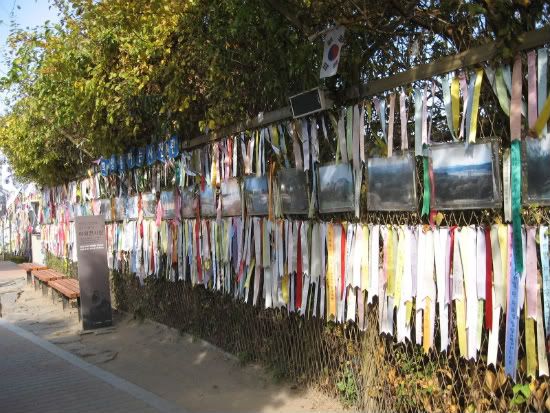

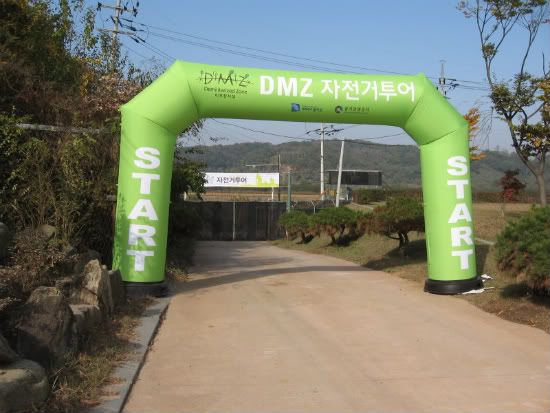
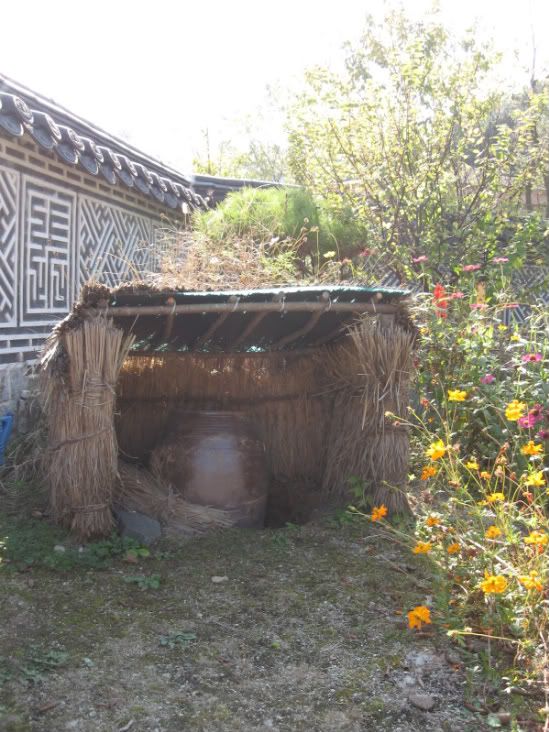

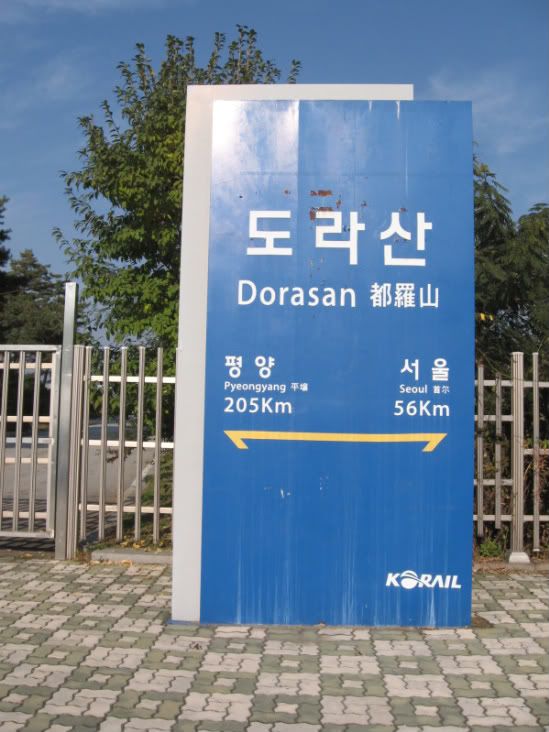
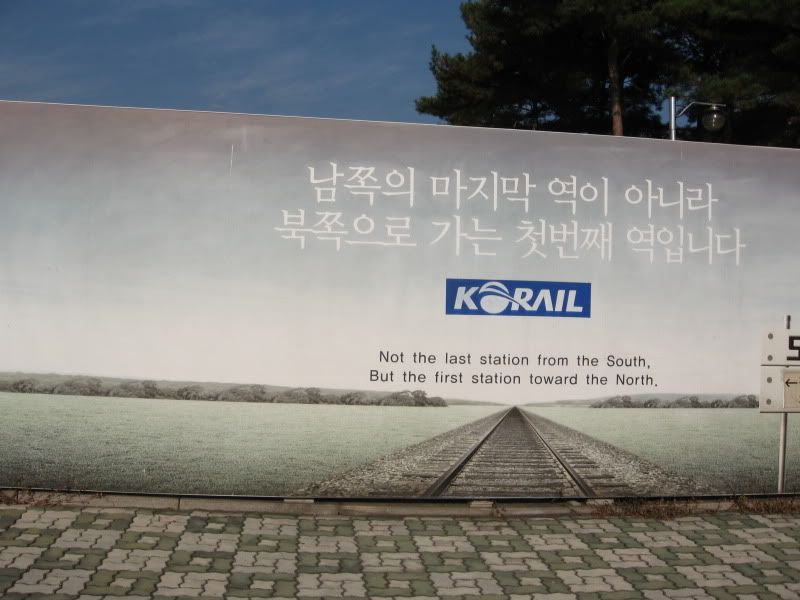
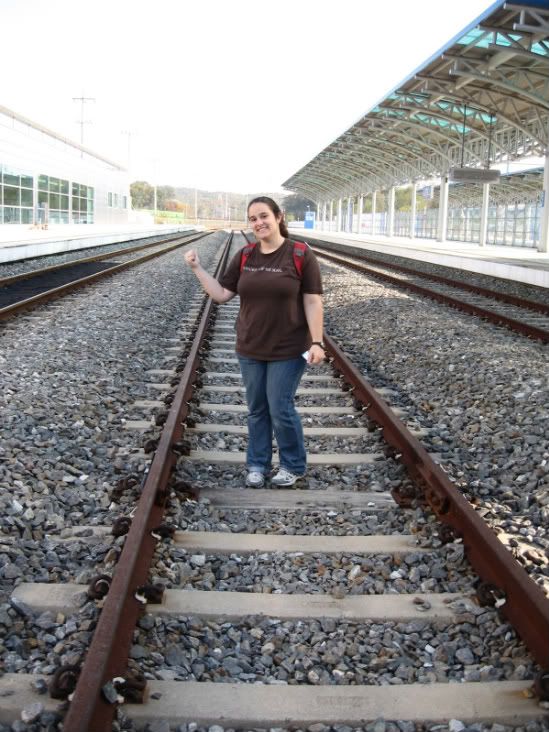
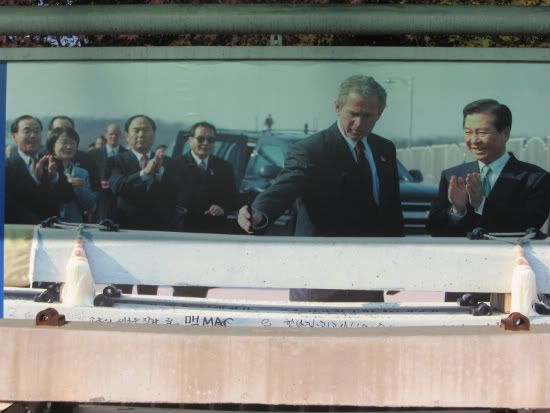
No comments:
Post a Comment